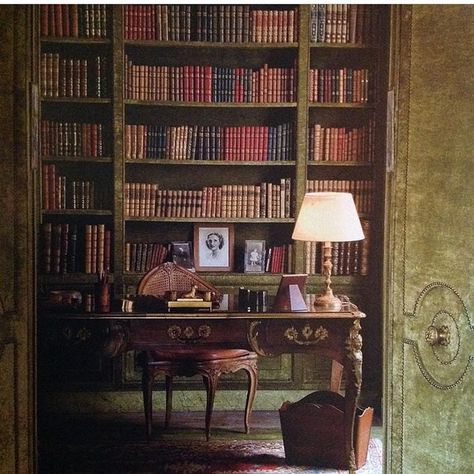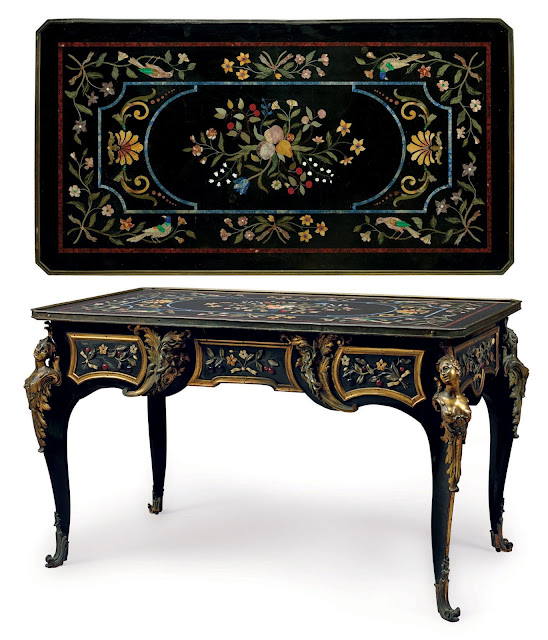The French bureau plat, also called table à écrire or "writing table", first appears at the end of the reign of Louis XIV. Up until that time the general public did not know how to read and write, and in addition all books and writing implements were comparatively costly. At the beginning of the 17th century the bureau plat was just a flat table with drawers below the top.
Furniture devoted to writing while seated and with drawers for storage began appearing in the second half of the 17th century and were generally French and part of an "office" described as "bureau". A single one of these became known as a bureau plat. By Louis XIV's reign, the bureau plat was a kneehole style desk with a tier of drawers on each side and a single drawer in the center above a knees.
Under Louis XV there was a softening of the previous masculine magnificence into a more gentile and feminine style, much less formal and smaller in scale, which came to be known as Rococo. By the early 18th century the bureau plat had assumed its present form of three single frieze drawers across the front and four gently curved cabriole legs.
The French bureau plat is as functional and versatile as it is refined, graceful, and elegant. This is a pièce de résistance that will display beautifully in any interior. Whether you find a fine 18th century antique bureau plat or a lovely 20th century reproduction, you can count on it drawing attention and appreciation wherever it is placed.
The French bureau plat is a handsome and classic piece of French furniture that just shouts elegance and style.
via Pinterest
Raised on elegant cabriole legs with ormolu mounts and feet, this is a truly spectacular piece of furniture.
The desire for a more lighthearted and simpler style prompted Louis XV to transform some of the grander rooms at Versailles into more intimate spaces where a lighter style of furniture was more in keeping with the look. The bureau plat also underwent changes that took on a more feminine look with subtle curves.
The curve of the bureau plat's underframe flourished during the Louis XV style period.
Chateau de Beaumesnil
While the French bureau plat has a refined and sophisticated appearance, in short, a bureau plat was nothing other than a writing desk.
Therefore, a French bureau plat always supplies a large writing surface.
via Pinterest
The French bureau plat top is usually inset with leather or covered with materials that would perform equally well with a fountain pen or quill.
Also in true antique bureau plats there would have been special divisions for the inkwell, the blotter, and the sand or powder tray would have been found in one of the drawers.
via Pinterest
It took the work of a master craftsman to make a bureau plat and they were dedicated to the highest levels of details.
The artists preferred exotic veneers in their creations so most bureau plats would have been covered in burr walnut, kingwood, satinwood, or rosewood.
Also most antique French bureau plats feature ormolu artistry. Ormolu, from the French moulu, stands for ground or pounded gold, and is actually an English term. It was used since the 18th century for the gilding technique of applying finely ground gold–mercury amalgam to a bronze object. The mercury is driven off in a kiln leaving behind a gold coating. The French refer to this technique as ‘bronze doré’ while in English it is known as ‘gilt bronze’.
An antique bureau plat will have it's border decorated with ormolu for additional elegance and protection. This beauty was in the former Paris apartment of the Duke and Duchess of Windsor, decorated by Stephane
Boudin.
On many French bureau plats you will see beautiful artistic marquetry....
while on others there would be parquetry requiring the finest of craftsmanship.
The legs could also be tapered in shiny ormolu pieces all the way down to the feet which would be covered with bronze sabots to give the French bureau plat a strikingly unique look.
via Pinterest
Alidad Interiors, London
via Pinterest
Since bureau plats were conventionally associated with the professional world of men,
very few women owned writing desks.
John Fowler Designer
Marie Antoinette was said to have had a small bureau plat like this one, but this was uncommon.
Château de Chanteloup's interior
The French bureau plat is also very versatile. This writing table can double as a fabulous sofa table on which to display family pictures, bibelots, or other collectibles.
Metropolitan Museum of Art
The French bureau plat is a piece of furniture that can stand on it's own in the center of a room since it is finished on all sides and looks great from all angles.
J. Paul Getty Museum
The bureau plat epitomizes the "golden age" of furniture design which was a time that furniture was created for the dual purpose of being highly decorative and yet functional.
Vizcaya Museum
via Pinterest
These French bureau plats are delicate enough to not tip the balance in an all white or ivory room.
See how pretty this bureau plat looks resting on an antique Aubusson rug in soft pastel colors.
Newbridge House
You are likely to find these pieces of furniture in the home library, where it serves both as a reading and writing table.
source unknown
Every nobleman had a library where he did most of his business transactions so it was not uncommon for the bureau plat to also be called the library table.
These pieces can be decorated in a feminine as well as masculine style.
It is all in your decision as to what items you want to display on it.
If you want a room to cry out "French", a bureau plat will do that for you!
Alberto Pinto
Stunning French black lacquered bureau plat with dore bronze trim.
Many versions, often ebonised, were made during the Victorian period in the Rococo style and continue to be made in the same style at the present time.
An imposing Napoleon III ebonized bureau plat with fine gilt bronze mounts and pietre dure (inlay technique using cut, fitted, and highly polished stones to create images).
Here is an example of a French bureau plat after André Charles Boulle's beautiful signature style (1642-1732) featuring inlay with brass, ebony and tortoiseshell.
Chinoiserie bureau plats are beautiful as well. This one is lacquered in brilliant crimson and with Asian landscape scenes in gold which was fashionable in France as veneer for furniture in the middle of the eighteenth century.
Jessica McClintock
Many people love painted French furniture so will prefer a painted bureau plat. These are usually reproductions instead if true antiques.
This is a fabulous faux malachite painted bureau plat by designer Tony Duquette.
Today, people who truly appreciate French furniture put buying an antique bureau plat on their To Do List. I let one go at auction last year that I could kick myself for..... but it wasn't the "bargain" I was hoping for. But it was an incredible price.
However you choose to display a French bureau plat they will become instant focal points.
As you can see they fit into almost every style interior from cottage....
The French bureau plat has a refined and elegant look making them perfect for contemporary interiors too.
Click here to see the previous post
This blog post was published by Lisa Farmer
In the event that I have not credited the correct source of an image, please contact me at lisafarmerdesigns46@yahoo.com and I would be glad to correct it.
























































